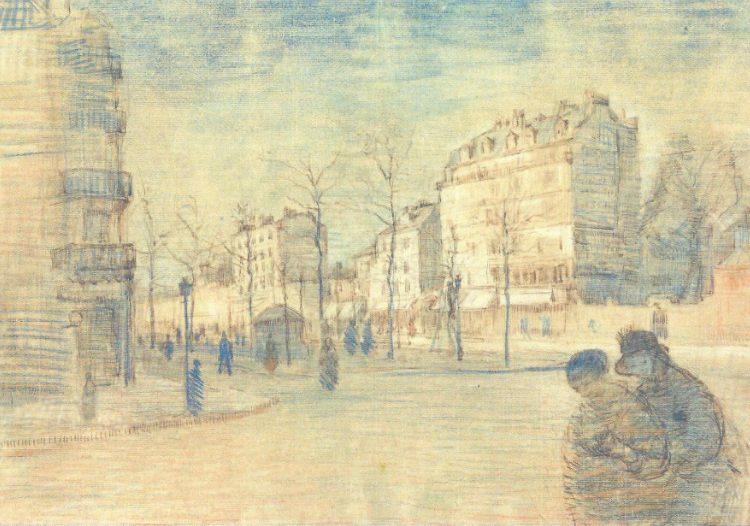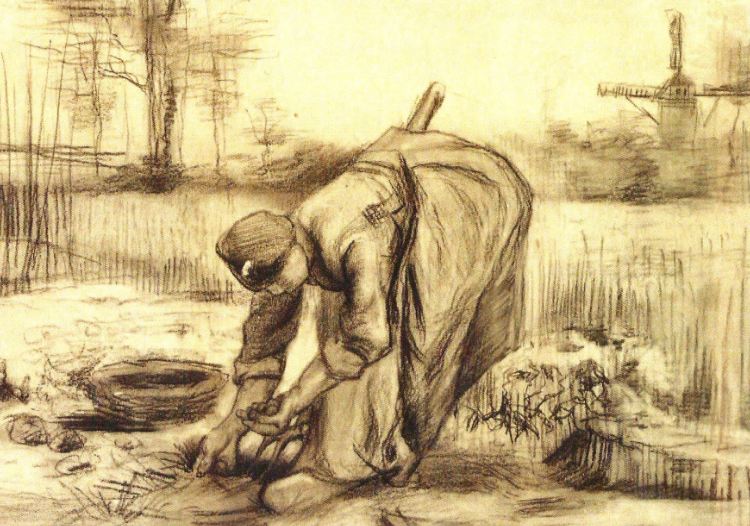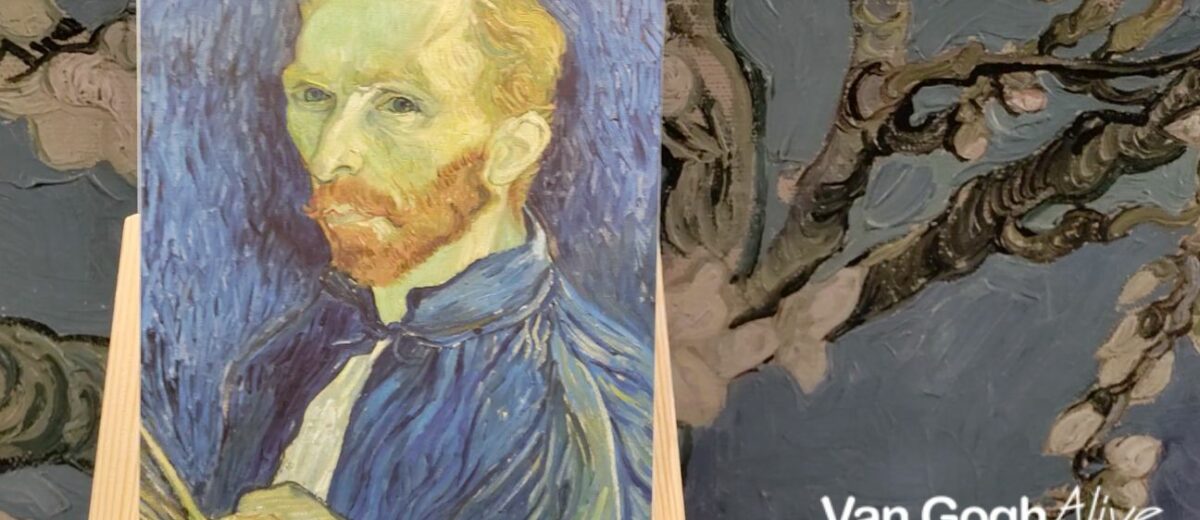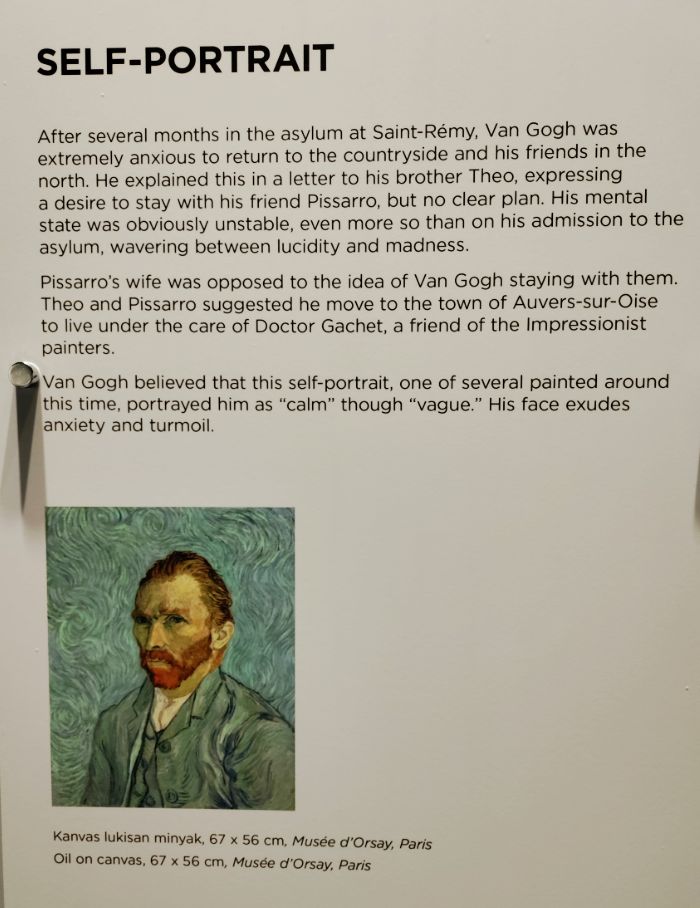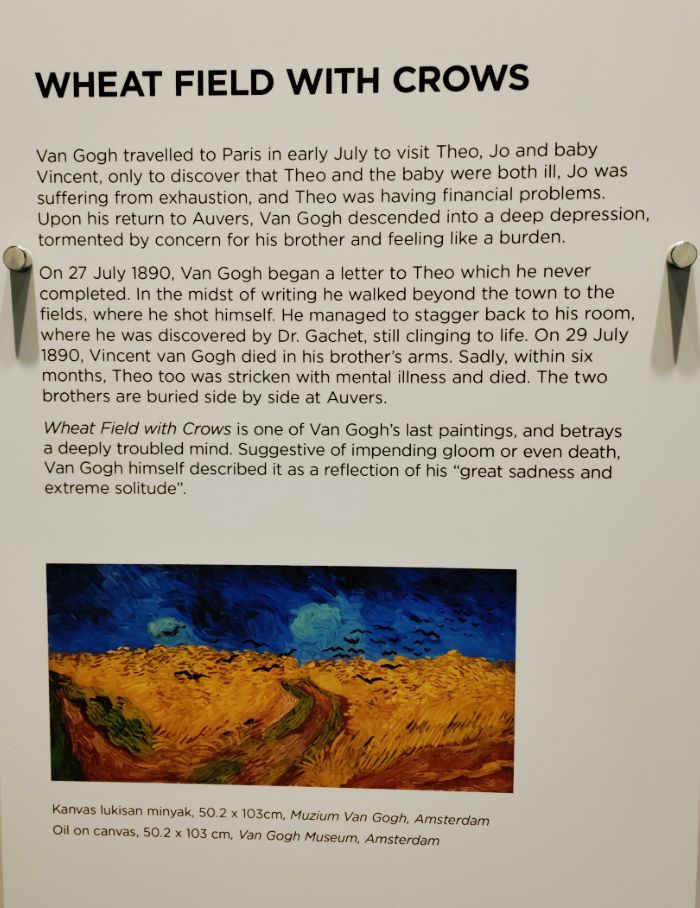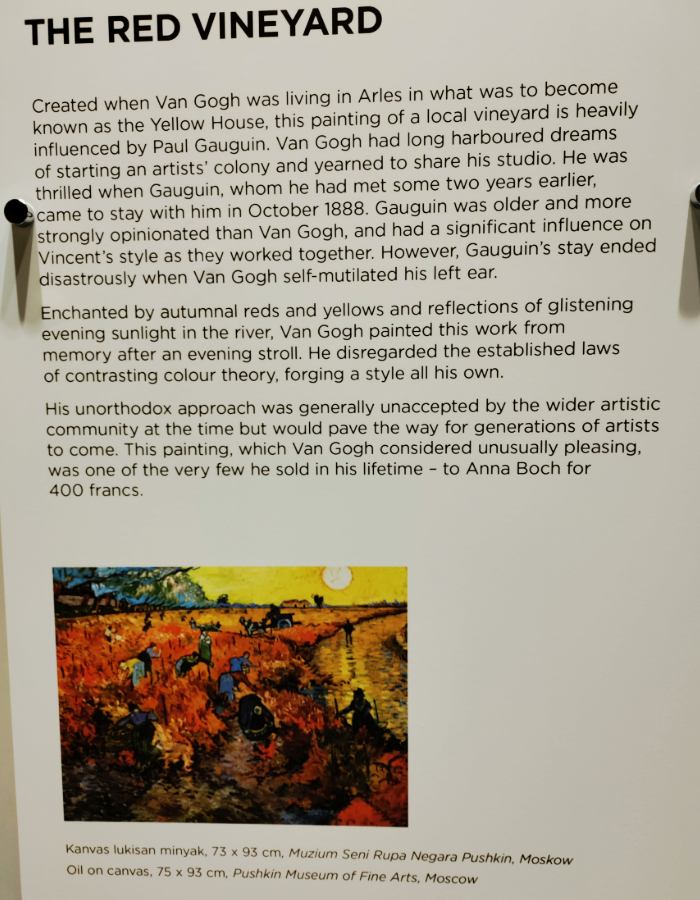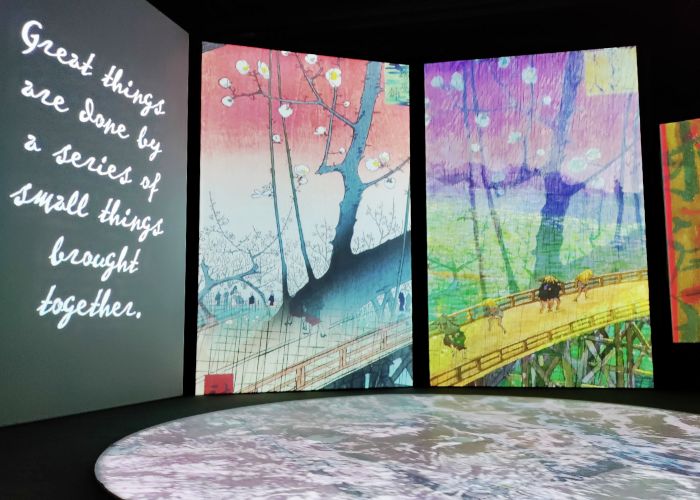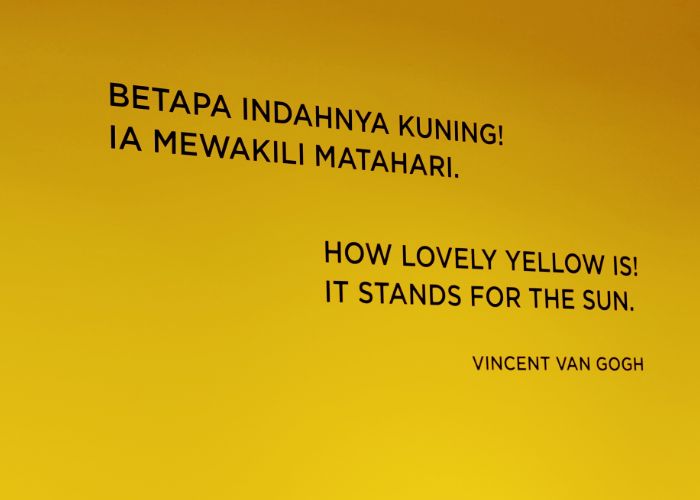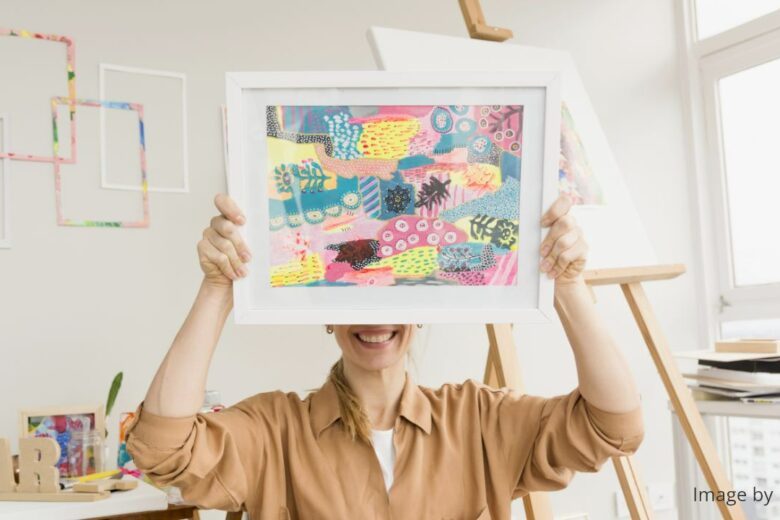When I came across an article headline from a local news portal, I jumped at the chance of visiting the Van Gogh Alive Exhibition.
Before the exhibition, I only knew about Vincent Van Gogh as a world-famous artist, best known for his Starry Night and Sunflower paintings and his insane behaviour in cutting off his own ear.
The exhibition was ground-breaking indeed and left me feeling immensely touched and full of admiration for the life this man lived…it moved me to tears.
My Experience
This was mostly a digital exhibition in which you could immerse yourself in Van Gogh’s colourful paintings and learn about the artist’s life.
There was also an interactive recreation of one of his most famous paintings, “Bedroom in Arles,” in which you could “enter” his bedroom.
Now, I know a lot more about the story behind the “Bedroom in Arles”. In short, this is a painting of his bedroom in the ‘Yellow House’ where he once lived in Arles, south of France.
In fact, Van Gogh painted three versions of his bedroom and sketched version of it in letters he sent to his brother Theo and his artist friend, Paul Gauguin. All versions of the painting conveyed “absolute restfulness”.
There were a lot more descriptions and anecdotes of his other well-known artworks showcased inside the exhibition room. I read all of them and got a glimpse into how he lived his life.
Then, I entered another room where all the immersive experience began. It’s a digital showcase of Van Gogh’s works – ranging from his early paintings of still life and people in dark, muted tones, to the lively style he later developed, which is evident in many of his well-known bright and colourful paintings.
What intrigued me the most was his Japanese paintings and the story of how he got inspiration from artists and important books to create them.
Because I’ve not seen these paintings before, they piqued my interest so much that I did additional research to learn more about the influence of Japanese art on Van Gogh’s works.
Japanese Paintings
Van Gogh had a collection of Japanese prints and ukiyo-e woodcuts from Hiroshige’s collection of “One Hundred Great Views of Edo”. He pinned them to the wall of his room and later, adopted their style in some of his paintings.
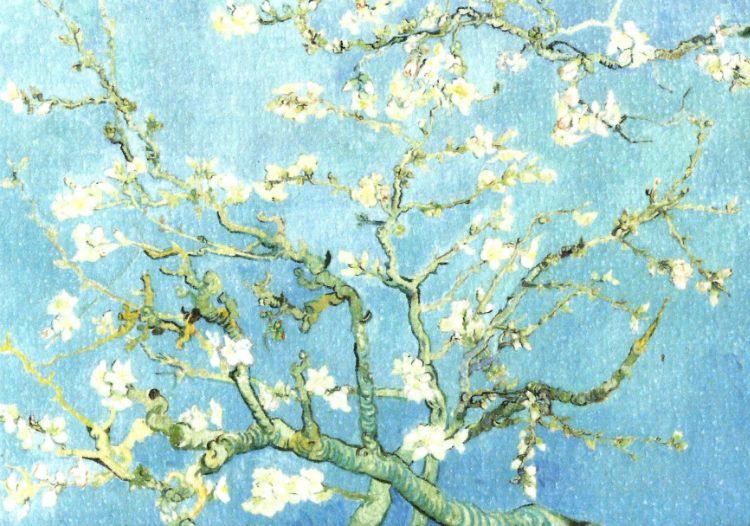
I found more information here. Feel free to take a look:
To Paris with Love
In the spring of 1886, he moved to Paris and settled in Montmartre, a suburb at the heart of Parisian culture and creativity. It was here that Van Gogh met and was influenced by post-impressionist artists such as Louis Anquetin, Emile Bernard, Edgar Degas, Paul Gauguin, Camille Pissarro, and Henri de Toulouse-Lautrec.
In Paris, Vincent abandoned the dark subdued tones of his ‘Dutch’ period, instead emphasising vibrant colour, lines, and patterns to convey symbolic and expressive emotions rather than simply depicting lighting, shades, and atmosphere.
“Instead of trying to reproduce exactly what I have before my eyes, I use colour more arbitrarily so as to express myself more forcibly.” – Vincent Van Gogh
Enchanted by the local landscape and its equally amazing night lights, Van Gogh soon realized his artistic breakthrough here.
In 1888 while living Arles, he painted a series of still-life sunflowers as a modest gesture to prepare his ‘Yellow House’ residence for the arrival of his friend Paul Gauguin. Today, Van Gogh’s magnificent Sunflowers series have become the world’s most instantly recognisable paintings.
Starry Starry Night
I learned at the exhibition that Van Gogh was a self-taught artist. He also wrote numerous letters to his brother Theo. But what amazed me the most was – in a span of only ten years; from when he first started to draw and paint until his death at the age of 37, Van Gogh had reached the pinnacle of his artistic abilities. Many art historians believed so when he painted Starry Night.
That iconic masterpiece was created at a time when he was suffering from poor health and severe mental illness at the Saint-Paul-de-Mausole asylum.
Despite this difficult period of his life, Van Gogh was able to paint an astounding star-studded night sky (along with other paintings at the time), with a unique and extraordinary technique of movement, fluidity and light.
And did you know Don McLean wrote a song as a tribute to him also popularly known by the same name? When I heard it on the radio, I never paid much attention to the lyrics and just thought it was a romantic love song. But I always find the line “How you suffered for your sanity” a bit weird for a love song. Now I know better. It’s a beautiful song and I love the modern rendition sang by Lianne La Havas ^_^
His Self-Portraits
According to Van Gogh painting research experts from the Van Gogh Museum, Amsterdam, his self-portrait paintings were more of him experimenting with drawing human forms, rather than his obsession with painting himself. In his day, hiring models were expensive.
His Family
Following the exhibition, I became increasingly interested in Vincent Van Gogh’s life, I began reading more about him in articles and watching videos and films about him. Among them, “Lust for Life” and “Loving Vincent”.
If you’ve ever wondered how Vincent Van Gogh became a famous artist the world over, this documentary of Johanna van Gogh-Bonger will interest you.
From the late 19th century to the early 1900s, Van Gogh’s younger brother Theo and sister-in-law was instrumental in his rise to fame. Van Gogh’s nephew, also named Vincent Willem continued his mother’s efforts to preserving Van Gogh’s legacy and went on to found the Vincent van Gogh Foundation.
The face of post-impressionism art has changed forever thanks to Van Gogh’s family’s tireless effort and dedication to making Van Gogh and his vision known throughout the world. And thanks to his family, we are able to admire and continue to be inspired by Van Gogh’s art wherever we are.
Vincent Willem van Gogh was posthumously proclaimed as the Father of Modern Art.
“All of this, is very satisfying for me, for it’s the only thing that I can do in the memory of my husband and of Vincent.” – Jo van Gogh-Bonger
My Letter to Vincent
You will undoubtedly see Van Gogh’s unbridled passion in every piece of his paintings. He was a man who’s not afraid to explore, to cross boundaries and push limits. An artist who pours his heart and soul into his paintings.
It didn’t matter to him whether he painted well or not, or how many paintings he sold in his time. He had expressed himself fully and he knew the worth of what he stood for.
If there was a time machine, I would definitely want to use it to go back to 1888 so that I could hand deliver a letter to Vincent at his ‘Yellow House’ residence. In tribute to a man who desired to love unconditionally, here’s what I will say…
Dear Vincent,
Indeed, during your time people didn’t know how to appreciate your work and contribution. That’s because you were not a mediocre person. You were extraordinarily brilliant, ahead of the time and ahead of everyone else, when it comes to showing your unconditional love.
You did it in your own unique way to touch people’s hearts. Even now, you continue to touch the hearts of millions of people through your works of art. You’ve definitely touched mine.
Now I know what you’re trying to say to me; that I can be the person I want to be and perhaps meant to be – to love and be loved.
Vincent, your dream has been fully realized.
Last but not least, to you who have read all the way to the end of this page, I hope you, too, will believe you can be the person you want to be.
Thank you for reading.
With sincerest gratitude,
Hazel Lee
